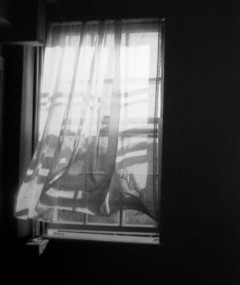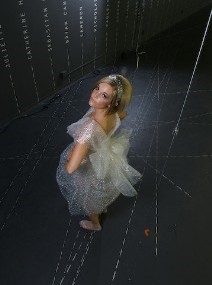How did you get started in photography?
 Amber: I got started in photography when I was in high school. I had an inspirational teacher, Mr. Ibach, who played jazz everyday as we printed our black and white photographs in the dark room. I became addicted, but wasn’t very good yet. The turning point for me was when I spent a summer at UC Santa Barbara, studying in their Summer Juniors Program, where I was introduced to college rigor and conceptual art. With a strong portfolio, I soon found myself at UCLA, pursuing a bachelor in fine arts and studying with such professors as James Welling, Morgan Fisher and John Baldassari.
Amber: I got started in photography when I was in high school. I had an inspirational teacher, Mr. Ibach, who played jazz everyday as we printed our black and white photographs in the dark room. I became addicted, but wasn’t very good yet. The turning point for me was when I spent a summer at UC Santa Barbara, studying in their Summer Juniors Program, where I was introduced to college rigor and conceptual art. With a strong portfolio, I soon found myself at UCLA, pursuing a bachelor in fine arts and studying with such professors as James Welling, Morgan Fisher and John Baldassari.
What type of equipment do you use?
 Amber: I shoot primarily with four cameras. For film, I use a Canon Rebel Ti and my Holga plastic camera. For digital, I use the Canon Rebel XT for more serious work and then my compact Canon A6 for daily shots. I carry a camera everywhere I go.
Amber: I shoot primarily with four cameras. For film, I use a Canon Rebel Ti and my Holga plastic camera. For digital, I use the Canon Rebel XT for more serious work and then my compact Canon A6 for daily shots. I carry a camera everywhere I go.
Who are your main influences?
Amber: Uta Barth, Thomas Struth and Andreas Gursky. I love the work of Cindy Sherman, but I don’t see her influence in any of my work. And one of my former professors, James Welling, must have influenced me because we end up shooting similar things, even if I can’t say exactly what he did to shape me.
What have you been doing recently in your career?
Amber: Currently, I am a photography teacher, teaching high school seniors the beauty of silver printing. I am also pursuing my masters in art education, writing a thesis on the benefits of analog photography in the age of digital. Lastly, I belong to an art collective called the LA Art Girls, a group of female artists who collaborate on art pieces, critique one another’s artwork and support one another in each other’s careers. We have performed and shown at The Getty, Los Angeles County Exhibition Space (LACE) and the Q.E.D. gallery.
What kind of repeated themes do you emphasize in your work?
 Amber: I don’t know if I have many repeated themes. In my last few series, I have more differences than similarities. In my Window series, I try to capture the nostalgia of summer, and the sadness or longing of looking out from spaces, as though the viewer is trapped. These photographs tend to focus on stillness and emptiness, while my next series, Motorcycles in Vietnam, emphasizes chaos and motion. I think these pictures use the medium of traffic to visually demonstrate vast differences between the East and West modes of thinking. The series also resonates personally with me, since my father fought in the Vietnam war. Then there are my Christmas tree photos, which are just a funny, dark joke. I find it interesting that we spend so much time, energy and money to decorate our homes and tout the idol of a Christmas tree and then we throw it all away. The pictures are a way to poke fun at our consumerism and reveal the cheapness of how people treat the holiday, and I also like the strange juxtaposition of an urban city landscape and farm-raised trees.
Amber: I don’t know if I have many repeated themes. In my last few series, I have more differences than similarities. In my Window series, I try to capture the nostalgia of summer, and the sadness or longing of looking out from spaces, as though the viewer is trapped. These photographs tend to focus on stillness and emptiness, while my next series, Motorcycles in Vietnam, emphasizes chaos and motion. I think these pictures use the medium of traffic to visually demonstrate vast differences between the East and West modes of thinking. The series also resonates personally with me, since my father fought in the Vietnam war. Then there are my Christmas tree photos, which are just a funny, dark joke. I find it interesting that we spend so much time, energy and money to decorate our homes and tout the idol of a Christmas tree and then we throw it all away. The pictures are a way to poke fun at our consumerism and reveal the cheapness of how people treat the holiday, and I also like the strange juxtaposition of an urban city landscape and farm-raised trees.
How has AEM helped you become a better artist as you integrate your faith and your art?
 Amber: Let me count the ways. One, AEM has given me the space to display my work at the wildly popular Evening of Arts and Entertainment. Two, it’s also provided a whole community of artists who understand me, support me, and empathize with my artistic and spiritual struggles. I don’t feel so alone now as a Christian artist. Plus, I find it really encouraging to see fellow artists working across the whole spectrum of the arts, from graphic design to music to producing films. And third, we often talk about how our artwork doesn’t have to be explicitly Christian, and that’s been a freeing notion. Now I can just make art about being human and don’t have to force spiritual ideas where they don’t fit.
Amber: Let me count the ways. One, AEM has given me the space to display my work at the wildly popular Evening of Arts and Entertainment. Two, it’s also provided a whole community of artists who understand me, support me, and empathize with my artistic and spiritual struggles. I don’t feel so alone now as a Christian artist. Plus, I find it really encouraging to see fellow artists working across the whole spectrum of the arts, from graphic design to music to producing films. And third, we often talk about how our artwork doesn’t have to be explicitly Christian, and that’s been a freeing notion. Now I can just make art about being human and don’t have to force spiritual ideas where they don’t fit.
Have you had any struggles with the integration of your faith and your art?
 Amber: No. I mean, back when I was in college, ten years ago, when I first became a Christian, I might have had problems, but as I matured as a person and as a Christian, I’ve moved on to other challenges, like simply producing good work. Also, now I don’t care what people think. All my friends who are artists know that I’m a Christian — I’m very open and honest about my faith. And there are sometimes collaborative art pieces that I choose not to participate in because they go against my faith.
Amber: No. I mean, back when I was in college, ten years ago, when I first became a Christian, I might have had problems, but as I matured as a person and as a Christian, I’ve moved on to other challenges, like simply producing good work. Also, now I don’t care what people think. All my friends who are artists know that I’m a Christian — I’m very open and honest about my faith. And there are sometimes collaborative art pieces that I choose not to participate in because they go against my faith.
What about how your relationship with God impacts your ideas for creativity?
Amber: Before I was a Christian, I was a very young naive artist and my artwork was about cliched and predictable and “beautiful” things. But then I became much more interested in the mundane and the ugly and the overlooked and tried to reveal the not-so-obvious beauty of the ordinary because God’s hand is in everything. It was a combination of being entrenched in modernist and conceptual art theory in art school as well as becoming a Christian.
What advice do you offer to budding photographers?
Amber: To look at a lot of work and go to galleries. Read Art Forum, which is not one of the lowbrow photo magazines like Photo magazine. It’s like the Harper’s of photography magazines. But the most important thing is to become part of a community of artists who can help critique your work.
Article By John Fox